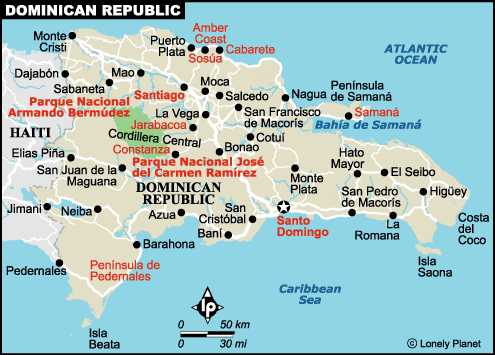Unit 1: Lesson 3
Unit 1 Lesson 3: Dominican Republic

Dominican Republic
In this last Unit Lesson, we are going to explore some of the Hispanic-speaking cultures through one of the 21 Spanish-speaking countries. For this lesson, you will need speakers or headphones.
Let's begin! Vamos a comenzar!
The Dominican Republic in the West Indies occupies the eastern two-thirds of the island of Hispaniola, which it shares with Haiti. Its area equals that of Vermont and New Hampshire combined. At 10,417 ft (3,175 m), Duarte Peak is the highest point in the West Indies.
Government
Representative democracy.
History Columbus explored the Dominican Republic on his first voyage in 1492. He named it La Española; his son, Diego, was its first viceroy. The capital, Santo Domingo, founded in 1496, is the oldest European settlement in the Western Hemisphere.
Spain ceded the colony to France in 1795, and Haitian blacks under Toussaint L'Ouverture conquered it in 1801. In 1808, the people revolted and captured Santo Domingo the following year, setting up the first republic. Spain regained its title to the colony in 1814. 1821 Spanish rule was overthrown, but in 1822, the Haitians reconquered the colony. In 1844, the Haitians were thrown out, and the Dominican Republic was established, headed by Pedro Santana. Uprisings and Haitian attacks led Santana to make the country a province of Spain from 1861 to 1865.
President Buenaventura Báez faced an economy in shambles and attempted to have the country annexed to the U.S. in 1870, but the U.S. Senate refused to ratify a treaty of annexation. Disorder continued until the dictatorship of Ulíses Heureaux; in 1916, when chaos broke out again, the U.S. sent in a contingent of marines, who remained until 1924.
A sergeant in the Dominican army trained by the marines, Rafaél Leonides Trujillo Molina, overthrew Horacio Vásquez in 1930 and established a dictatorship that lasted until his assassination in 1961, 31 years later. In 1962, Juan Bosch of the leftist Dominican Revolutionary Party became the first democratically elected president in four decades.

Details
Land area: 18,680 sq mi (48,381 sq km); total area: 18,815 sq mi (48,730 sq km)
Population (2012 est.): 10,088,598 (growth rate: 1.31%);
Birth rate: 19.44/1000
Infant mortality rate: 21.3/1000
Life expectancy: 77.44
Density per sq km: 196
Capital and largest city (2009 est.): Santo Domingo, 2,138,000
Other large city: Santiago de los Caballeros, 501,800
Monetary unit: Dominican PesoHola!
